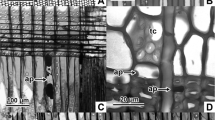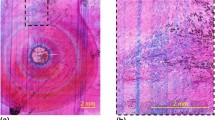Abstract
Key message
This paper provides a new anatomical model for how branches are joined together at forks in trees, using evidence from MicroXCT scanning, ESEM output and visual observation.
Abstract
Wood grain arrangements at the forks and other junctions within a tree must be arranged to mechanically join together the two or more branches, yet not adversely restrict sap flow. The grain orientation at junctions therefore represents a trade-off in xylem performance between the functions of efficient sap conductance and the provision of adequate load-bearing capacity. Initial observations of wood grain orientation were made on the surfaces of several dozen debarked and fractured bifurcations of a wide range of tree species, both by eye and using a scanning electron microscope. Subsequently, small volumes of wood were sampled from two locations within the junctions of hazel, at the junction apex and on the outer section of join. Wood was imaged in 3D using high-resolution X-ray tomography, and the scanned volumes were analysed for their wood grain patterns. It was found that the wood at the junctions of hazel forks contained only 37 % of the number of vessels contained in wood within the adjacent stem. The vessel elements formed at the junctions were only 32.5 % the length of those in the stem, had a mean diameter only 50.5 % of the stem vessels and consequently only 26.3 % of their lumen volume. The passage of the vessels through the fork wood deviated from a straight line (Euclidean) distance by more than 14 times more than the stem wood vessels did. The interweaving of vessels in the fork wood was over 22 times greater than in the stem wood. A survey of rays showed them to be 58 % more abundant in fork wood but only 62 % of the height of rays in the stem wood. These results suggest that where two branches of similar diameter join to form a tree fork, an interlocking wood grain pattern is formed at the apex of the bifurcation, which provides higher tensile strength to the junction. Breaking of the hazel fork requires wood fibres to be stretched axially and broken across, which requires greater stress than breaking normal wood radially or tangentially.










Similar content being viewed by others
References
Bradley RS, Withers PJ (2014) On the measurement of tortuosity of tube-like structures from noisy 3D data, paper in preparation
Bradley RS, McNeil A, Withers PJ (2010) An examination of phase retrieval algorithms as applied to phase contrast tomography using laboratory sources. SPIE, Proc 7804
Burgert I, Bernasconi A, Eckstein D (1999) Evidence for the strength function of rays in living trees. Holz Roh Workstoff 57:397–399
Burns LA, Mouritz AP, Pook D, Feih S (2012) Bio-inspired design of aerospace composite joints for improved damage tolerance. Compos Struct 94:995–1004
Carlquist S (2001) Comparative wood anatomy 2nd Ed.In: Springer Series in Wood Science. Springer-Verlag, New York
Dresch HE, Dinwoodie JM (1996) Timber; structure, properties, conversion and use. MacMillan Press Ltd, London
Ennos AR (2012) Solid biomechanics. Princeton University Press, New Jersey
Ennos AR, Van Casteren A (2010) Transverse stresses and modes of failure in tree branches and other beams. Proc R Soc B 277:1253–1258
Hildebrand T, Rűesgsegger P (1996) A new method for the model-independent assessment of thickness in three-dimensional images. J Microsc 185:67–75
Jane FW (1962) The Structure of Wood. Adam C Black, London
Katz RA, Pizer SM (2003) Untangling the Blum medial axis transform. Int J Computer Vision 22:139–153
Kramer PJ, Kozlowski TT (1979) Physiology of woody plants. Academic Press, New York
Lev-Yadun S, Aloni R (1990) Vascular differentiation in branch junctions of trees: circular patterns and functional significance. Trees 4:49–54
Meyer F (1994) Topographic distance and watershed lines. Sig Process 38:113–125
Schweingruber FH, Börner A, Schulze E-D (2006) Atlas of woody plant stems; evolution, structure and environmental modifications. Springer-Verlag, New York
Shigo A (1985) How branches are attached to trunks. Can J Bot 63(8):1391–1401
Slater D, Ennos R (2013) Determining the mechanical properties of hazel forks by testing their component parts; Trees: structure and function (paper accepted 19 June 2013)
Slater D, Harbinson CJ (2010) Towards a new model for branch attachment. J Arboric 33(2):95–105
Turner IM (2001) The ecology of trees in the tropical rain forest. CUP, Cambridge
van Casteren A, Sellers W, Thorpe S, Coward S, Crompton R, Ennos AR (2012) Why don’t branches snap? The mechanics of bending failure in three temperature angiosperm trees. Trees 26:789–797
Zimmermann MH, Brown CL (1971) Trees: structure and function. Springer-Verlag, New York
Author contribution statement
Duncan Slater: initiator of this investigation into branch attachment, PhD student of Professor Ennos, first author of this paper. Work for this paper involved collection of samples, segmentation of CT scanning data, statistical analysis and the writing of this paper. Dr. Robert Bradley: technical assistant to CT scanning, creator of algorithms that provided parameters from the segmented CT scanning data, reviewer of the original paper and author of part of the methods section of the paper (technical aspects of the CT scanning and algorithms used to analyse the raw data). Prof. Phil Withers: CT facility manager, supervisor of Dr. Robert Bradley and reviewer of the initial draft of this paper. Prof. Roland Ennos: Supervisor to Mr. Duncan Slater, editor and reviewer of this manuscript.
Acknowledgments
We would like to thank the following contributors: M. Carswell for the supply of hazel forks to assist with this study; D. Elwell and M. Heys for producing illustrative figures; Dr. T. Lowe for his advice on segmentation of our CT scans; A. Hirons for reviewing our findings; and BSc (Hons) graduates J. Barnes and C. Harbinson for their thoughts and ideas at the beginning.
Conflict of interest
The authors declare that they have no conflict of interest. P. Withers would like to acknowledge funding from the Engineering and Physical Sciences Research Council for the Manchester X-ray Imaging Facility under EP/F007906/1 and EP/F028431/1.
Author information
Authors and Affiliations
Corresponding author
Additional information
Communicated by M. Shane.
Rights and permissions
About this article
Cite this article
Slater, D., Bradley, R.S., Withers, P.J. et al. The anatomy and grain pattern in forks of hazel (Corylus avellana L.) and other tree species. Trees 28, 1437–1448 (2014). https://doi.org/10.1007/s00468-014-1047-5
Received:
Accepted:
Published:
Issue Date:
DOI: https://doi.org/10.1007/s00468-014-1047-5




